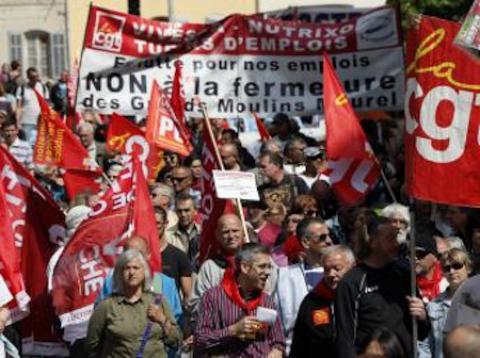May Day Rallies Held Around the World
Life in Canada, Home of the World’s Most Affluent Middle Class
Will Liberal Cities Leave the Rest of America Behind?
May Day Rallies Held Around the World
Mark Tran
May 1, 2014
For many May Day is simply a public holiday to mark the start of spring - although it's grey and wet in London. But for those who still believe in working class solidarity, today means more than a day off (in some parts of the world) , it is a celebration of hard won rights in the workplace.
May Day, or International Workers' Day, has its roots in America as it commemorates what is known as the Haymarket Massacre in Chicago in 1886, in which several demonstrators at a mass rally for an eight-hour workday were killed.
May 1 was subsequently chosen as the date for International Workers' Day by the Socialists and Communists of the Second International in 1891 to commemorate the massacre. Ironically May Day is no longer a public holiday in the US as it was considered too radical at the height of the cold war and the American Federation of Labor itself wanted distance from it.
It remains an important official holiday in China, North Korea, Cuba and Russia. This year, Indonesia will mark its first labour day national holiday. Among the workers taking part in Indonesia's May Day march are women who used to earn less than $1 an hour making Adidas shoes until they were sacked.
In Malaysia, the police said they would allow a May Day rally against price rises that will include opposition leader Anwar Ibrahim, retracting earlier statements that the protest would be illegal. The opposition-supported protest focused on price increases following subsidy cuts, as well as plans to introduce a general sales tax from next year.
CONTINUE READING COMPLETE COVERAGE HERE
Life in Canada, Home of the World’s Most Affluent Middle Class
Ian Austen and David Leonhardt
April 30, 2014
The Canadian middle class may now be the world’s richest, but it has its anxieties, too.
Members of the middle class in Canada worry about whether they can afford college for their children and whether their children will find jobs afterward. Housing costs are a major concern, as are everyday costs for transportation and mobile-phone plans. Middle-class Canadians worry about inequality.
Yet many also believe that they’re better off than their American counterparts.
We reported last week that median income in Canada appears to have surpassed median income in the United States, based on more than three decades of international income surveys analyzed by LIS, a research group, and by The Upshot. As recently as 2000, median income in the United States was significantly higher. The data also show that lower-income families in Canada and much of northern Europe now make more than their American counterparts.
To get a sense for how these trends are affecting Canadians, we set out to interview members of the middle class. Most, of course, have no firsthand way of comparing their experiences with American ones, and they were quick to acknowledge as much. Yet in a globalized world, people do know about more than just their own neighborhood.
And interviews suggest that many members of the Canadian middle class prefer the situation on their side of the border.
CONTINUE READING COMPLETE ARTICLE HERE
Will Liberal Cities Leave the Rest of America Behind?
Thomas B. Edsall
April 29, 2014
How can governments adopt substantial, effective policies in order to benefit the poor and the working class when corporations, the affluent and owners of capital can pull up stakes and relocate with ease?
The declining ability of the American political order to deliver a steadily rising standard of living to the vast middle and working classes began to show itself in the 1970s, well before most people grasped the significance of what was happening around them. Decades of globalization have been accompanied by diminishing opportunity for those in midlevel jobs; by stagnant wages, especially for men without college degrees; and by the virtual collapse of private-sector unionization.
Standing in opposition to these adverse trends, a wave of newly elected mayors from New York to Seattle has taken office committed to deploying the power of city government and aggressive wage and tax policies to attack inequality and revive social and economic mobility.
These outspoken mayors have generated a growing optimism on the Democratic left that local officials can restore support for government activism. Mayors and city councils, in this view, can lead the drive to improve the prospects and living conditions of those in the bottom third of the income distribution.
Harold Meyerson, the editor at large of The American Prospect, argues in “The Revolt of the Cities” that this insurgency is already in motion. Urban chief executives are raising minimum wages; requiring contractors to hire inner-city residents and to increase pay on municipal projects; backing local union organizing efforts; initiating or expanding pre-K schooling; extending public transit into poor neighborhoods; and requiring police to videotape contacts with citizens.
“They are, in short, enacting at the municipal level many of the major policy changes that progressives have found themselves unable to enact at the federal and state levels,” Meyerson writes. “They also may be charting a new course for American liberalism.”
Meyerson’s list of mayors charting the new liberalism includes (but is not limited to) Pittsburgh’s Bill Peduto, Minneapolis’s Betsy Hodges, Seattle’s Ed Murray, Boston’s Martin Walsh, Santa Fe’s Javier Gonzales and, of course, New York City’s Bill de Blasio.
The political impetus behind this ideological development is the fact that American cities are on the cutting edge of the current demographic transformation of the United States into a majority-minority nation.
Minorities are significantly more liberal and more pro-government than whites, according to survey data from American National Election Studies.


Spread the word